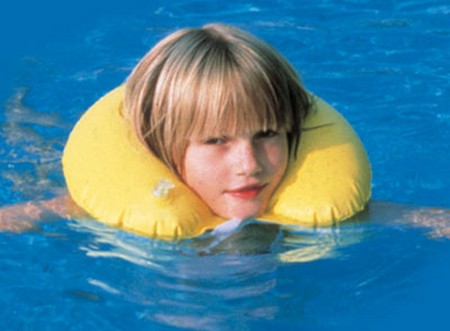This is one fault that everybody has in the early learning stages. The child rolls his head and looks back at his breathing arm but, instead of keeping his chin down to finish blowing out, at the last moment he jerks his head out in front. This is very bad.
The swimmer’s body should be in a flat position, and if the head lifts up out of the water the balance will be gone. Like a seesaw, the minute the head comes up, the feet will have to come down. Very often the reason for the head popping out in front, instead of being turned to the side, is that the children swim with their eyes closed. When the eyes are closed you cannot see where you are going. Instead of opening the eyes under the water, they only open their eyes when they breathe in. While they have their eyes open, they swing their heads up and forward to see where they are going.
Asthmatic children hate the feeling of their faces being under the water. They have a claustrobophic sensation and are prone to panic, fearing they won’t be able to lift their head out of the water in time to take another breath.
To correct the lifting of the head out front, the children should do a lot of the crocodile walk, the teacher walking along beside them, guiding the head movement with her hands. Also, one-arm breathing can be practiced, making sure that the chin touches the shoulders, then rolls down to the chest and back again.
Can’t Get Rid of the Air
I often hear it from my adult pupils: “When I put my face into the water, I somehow can’t get rid of the air.”
This can happen to children too. The time allowed between strokes is just not long enough to get rid of the air. In these cases, it’s advisable to teach breathing on every four strokes.
For the normal freestyle, you take a breath every time the breathing arm comes out of the water, and you blow out when the pushing arm goes over. Breathing on every fourth stroke means that you take a breath when the breathing arm comes out and you hold it for the next three strokes. The counting starts when an arm reaches out in front, so it goes: Take a breath—that’s one, face in the water—two, three, four—then take a breath again, face in the water; two, three, four.
There are two ways of getting rid of the air for this four-stroke style:
1. Let the air out slowly, bit by bit, carefully economizing to make it last through the four strokes.
2. Hold on to it until the very last stroke, and let it out with a big blow, and then take a breath in the normal way.
When first introducing breathing on every fourth stroke, it is advisable to let the pupils walk in shoulder-deep water, practicing breathing on every four strokes. This way everybody can experiment to find out which of the two methods of breathing suits them best.
